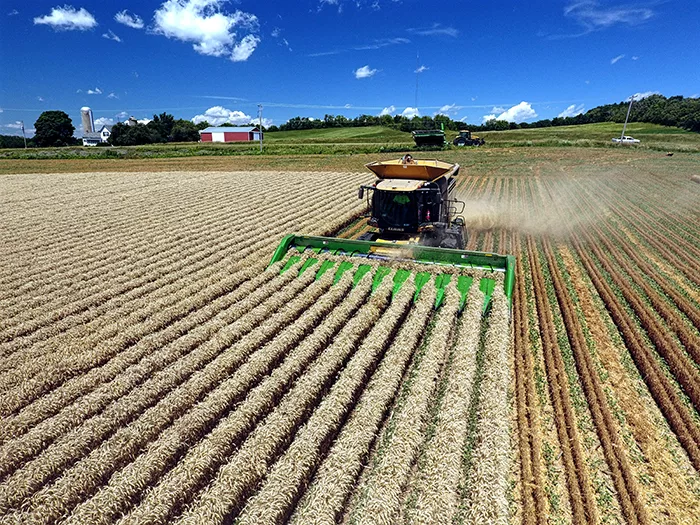
John Kutz has more than a decade of experience using GPS-guided and controlled equipment in his family’s 2,000 acre farming operation in Fort Atkinson, Wis. Kutz, who farms with his wife, Natalie, and parents, Dennis and Sally, also operates a tiling business as well as offers custom farming services that include chicken litter application, planting, spraying and harvesting to area farmers.
He twin-row plants corn on 30 inch centers and intercrops wheat and soybeans, seeding wheat first with a pass of the 24 row, 60 foot planter, then coming back in between the seeded wheat rows, planting twin-row soybeans. His custom-built planter started with a John Deere DB 60 planter tool bar that’s outfitted with Precision Planting eSet units and AirForce downpressure control, driven by a 20/20 monitor.
Kutz uses Yetter row cleaners because that is the only style he could find that would work with the twin-row setup. Keeton knives place starter fertilizer, although he is considering banding nitrogen over the row in the future because he is not seeing the yield response with the knifed-in application on ground that he’s also applied chicken litter. The auto-steering system on his Challenger MT865B is controlled by a Trimble FMX monitor that operates off an RTK signal for sub-inch accuracy.
“We started with the Deere GPS system in 2003, but switched to Trimble when we started using other equipment brands. The Trimble system works well with our Lexion combine for yield tracking and the system plays nicer with different brands of equipment.”
They use the Raven Viper 4 guidance system for their custom crop spraying operation that treats 20,000 acres annually. “We like the system for spraying and the software is set up so it makes billing easier,” he says.
Point of Pain: Leveraging Crop Management Software
Kutz says his twin-row corn, on average, yields 8 more bushels per acre than single-row planting, but that’s only possible because he tweaks population slightly upward and also pushes fertility.
“Others who have tried twin-row planting don’t see yield increases because they don’t fine-tune seeding and fertilizer rates,” he says. “We have been using Farm Works software for 7 years to manage data, but I have been frustrated with getting the right training to make more use of the mapping functions.”
Presently, Kutz uses the company’s soil-mapping function to help develop variable-rate seeding and fertilizer prescriptions, but struggles with laying over fertilizer and yield data to further fine tune seeding and application rates.
“There are not enough training seminars available to learn the higher levels that this program can do,” he says. “The closest ones to us have been in Minnesota or Indiana. I try to learn as much online as I can, but I still haven’t been able to push the data collection program far enough to take full advantage of its capabilities. For the most part, it is trial and error and self-teaching. I wish my dealer for the Raven and Trimble systems could help me more.”
Kutz says until he finds a more convenient way to acquire knowledge of the system, he’ll continue to fine tune population and fertilizer application on-the-go, based on past field and yield experience.



![[Technology Corner] A Big Step Forward for Interoperability & Data Sharing](https://www.precisionfarmingdealer.com/ext/resources/2025/12/12/A-Big-Step-Forward-for-Interoperability--Data-Sharing.webp?height=290&t=1765565632&width=400)


